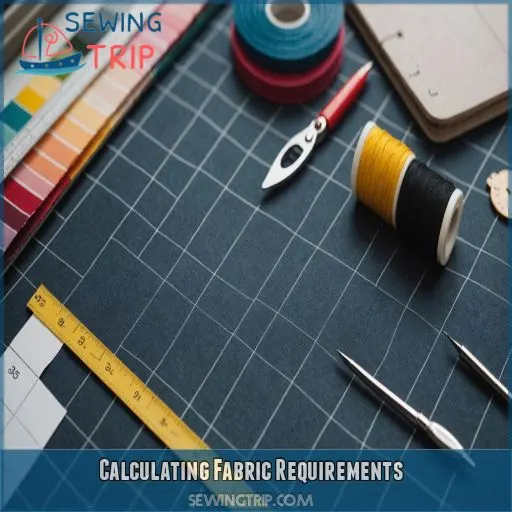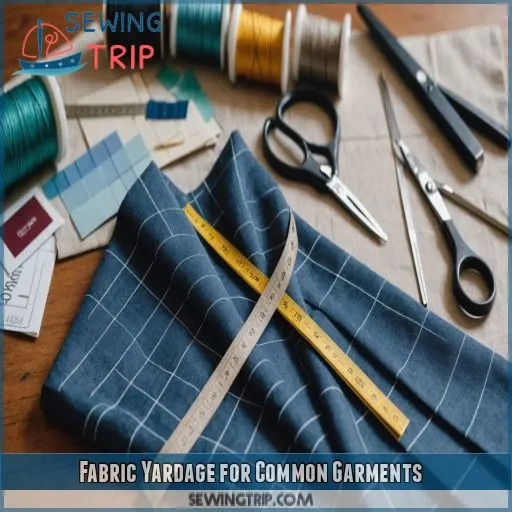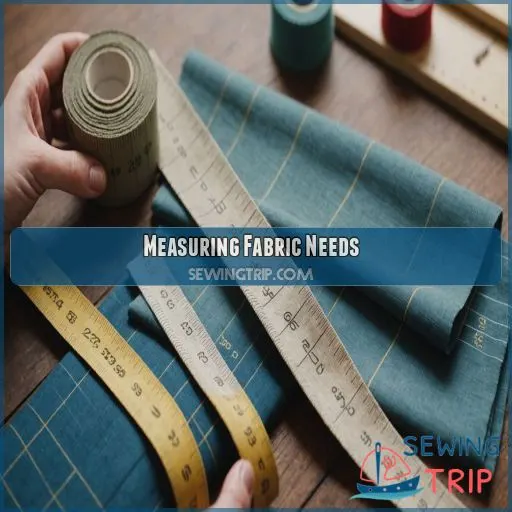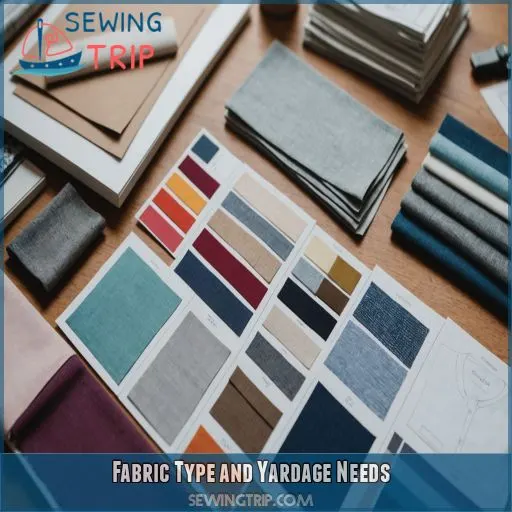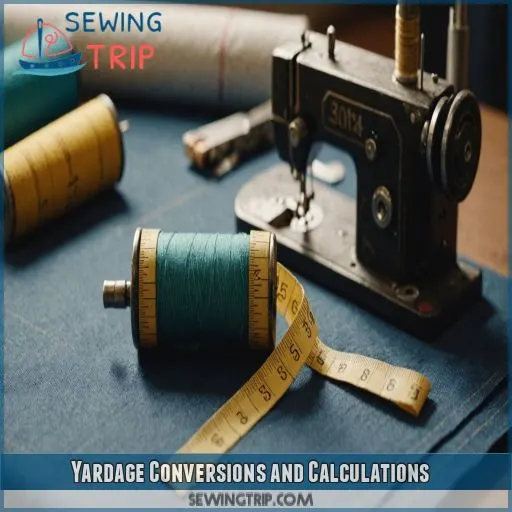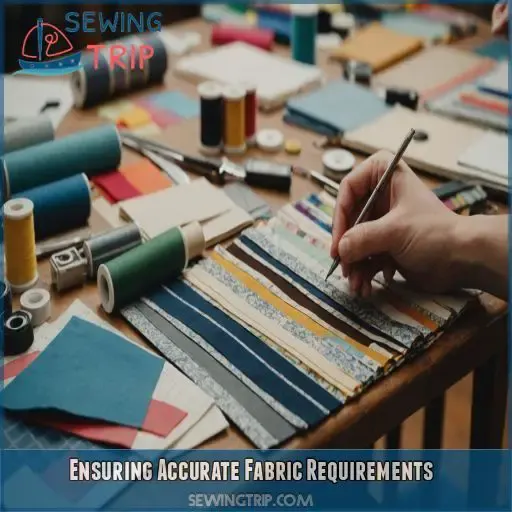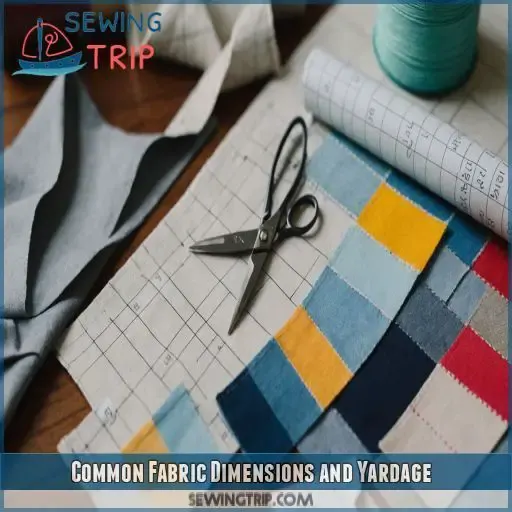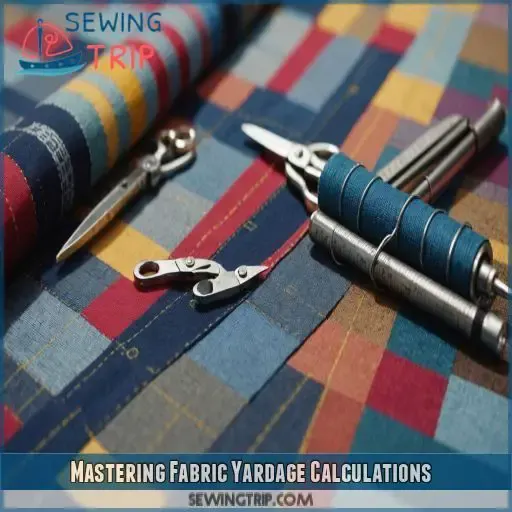This site is supported by our readers. We may earn a commission, at no cost to you, if you purchase through links.
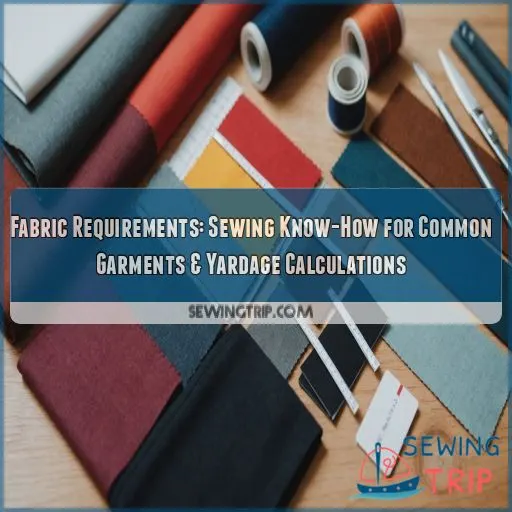
You’ll usually need 2-3 yards for dresses and skirts, depending on the style and how long you want it.
Shirts and blouses usually need 1.5-2 yards, while pants might need 2-3 yards.
Don’t forget to add extra fabric for pattern matching, seam allowances, and to make sure the clothes fit comfortably!
Stretch fabrics often need less than woven ones, so keep that in mind.
Table Of Contents
- Key Takeaways
- Calculating Fabric Requirements
- Fabric Yardage for Common Garments
- Measuring Fabric Needs
- Fabric Type and Yardage Needs
- Yardage Conversions and Calculations
- Ensuring Accurate Fabric Requirements
- Common Fabric Dimensions and Yardage
- Mastering Fabric Yardage Calculations
- Frequently Asked Questions (FAQs)
- Conclusion
Key Takeaways
- Don’t get caught with your pants down – always add a little extra fabric for seam allowances, pattern matching, and those "oops" moments. It’s like bringing a spare tire on a road trip – better to have it and not need it than need it and not have it!
- Fabric Width is your secret weapon. The wider the fabric, the less yardage you’ll need. It’s like getting more bang for your buck at an all-you-can-eat buffet!
- Stretch fabrics are the yoga pants of the sewing world – they’re flexible and forgiving. You’ll often need less yardage compared to woven fabrics, so you can stretch your budget too.
- Remember, calculating fabric needs isn’t rocket science, but it is a bit like solving a puzzle. Once you get the hang of it, you’ll be eyeballing yardage requirements faster than you can say "bobbin thread"!
Calculating Fabric Requirements
You’re about to start a new sewing project, and you’re wondering how much fabric you’ll need – a big question that can make or break your project’s success. Figuring out your fabric needs can seem tricky, but with a few simple steps and considerations, you’ll be able to estimate your fabric needs with confidence.
Understanding Yardage Needs
When sewing, calculating fabric requirements is really important to avoid waste and make sure your project goes smoothly.
To figure out how much yardage you need, consider your project’s size, pattern, and fabric type.
Don’t forget to factor in seam allowance, ease, and pattern matching.
A good rule of thumb is to add 1/4 yard to your total to account for any errors or adjustments.
Factors Influencing Yardage Calculations
When calculating fabric requirements, several factors come into play. Fabric weight, pattern complexity, and project size all impact yardage needs. Don’t forget to factor in seam allowances and fabric stretch, as these can make or break your project. By understanding these factors, you’ll be able to estimate fabric yardage with confidence and avoid costly mistakes.
Pattern Matching and Fabric Type
When working with patterned fabrics, you’ll need to pay attention to the repeat to make sure the pattern matches up perfectly.
For stripes, add the repeat length to your yardage calculation.
Plaids need an extra length of one plaid repeat per yard.
Directional prints, like florals, might need more fabric to accommodate the design.
Adjust your calculations to avoid mismatched seams.
Cutting Errors and Extra Fabric
We’ve all been there: you’re sewing a dress, and suddenly, you realize you cut a piece too small. Oops! That’s why it’s super important to account for cutting errors and add extra fabric yardage to your project calculations. Here’s the lowdown:
- Cutting Mistakes Happen: We’ve all been there: a slip of the hand, and you’ve cut outside the lines. Extra fabric gives wiggle room for human error.
- Fabric Waste is Real: Those scraps add up, and some projects require more waste than others.
- Seam Allowance: You need extra fabric for seams, hems, and fitting. No one wants ill-fitting pants!
- Peace of Mind: Having extra fabric keeps your project on track and stress-free.
- Creative Flexibility: Leftovers mean you can add a pocket, cuff, or fun detail.
Fabric Yardage for Common Garments
You’re ready to start sewing, but you’re not sure how much fabric you need for your project. In this section, we’ll break down the fabric yardage requirements for common garments, from dresses and skirts to shirts and pants, so you can plan your project with confidence.
Dresses and Skirts
When sewing dresses and skirts, consider the style, length, and fabric drape to determine yardage needs.
A-line dresses and skirts require more fabric than straight ones, while pleats and gathering add to the yardage.
Use a fabric yardage calculator to make sure you have enough.
For a standard dress, 2-3 yards of fabric is a good starting point, depending on size and seam allowances.
Shirts and Blouses
Shirts and blouses are wardrobe staples, and knowing the fabric requirements helps you avoid running out. Here’s a guide:
- Short-sleeved shirts/blouses: 2 yards of 35-36" fabric, 1-5/8 yards of 44-45" fabric, or 1-3/8 yards of 52-54" fabric.
- Long sleeves: Add a bit more fabric, about 2-1/2 yards, 2-1/8 yards, or 1-3/4 yards, respectively.
- Long-sleeved with ties: This style is a fabric eater, needing 3-3/4, 2-7/8, or 2-3/8 yards.
- Capped sleeves: Similar to short sleeves, you’ll need 2 yards, 1-5/8 yards, or 1-3/8 yards.
Pants and Shorts
Pants and shorts are wardrobe staples, and getting the fabric yardage right is key.
For full-length pants, you’ll need around 3-1/4 yards of 35–36" fabric.
Capri pants are shorter, so 2-3/4 yards is plenty.
Go for 2-1/2 yards if you’re sewing Bermuda shorts.
Fabric width options vary, so check before buying.
Add 1/4 yard for cuffs, and you’re set for a stylish, comfy pair of pants or shorts.
Jackets and Coats
Jackets and coats are a cozy challenge, demanding more fabric than most garments. Here’s the lowdown on yardage:
- Lining: Don’t forget the lining fabric, which usually matches the outer fabric.
- Fabric Weight: Heavier fabrics like wool or tweed are cozy but eat up more fabric.
- Seam Allowance: Jackets need wiggle room, so allow for larger seam allowances, especially at the hem.
Measuring Fabric Needs
When you’re getting ready to sew a new garment, you’ll want to make sure you have enough fabric to get the job done. To avoid running out of fabric mid-project, you’ll need to take accurate measurements and calculate your fabric needs carefully, considering factors like seam allowance, ease, and pattern piece placement.
Taking Project Measurements
To take project measurements, start by recording your body measurements and the garment length you want. Next, consider the fabric width and calculate how many pattern pieces will fit within it. Use the following table as a guide:
| Fabric Width | Pattern Pieces |
|---|---|
| 35-36 inches | 2-3 pieces |
| 44-45 inches | 3-4 pieces |
| 52-54 inches | 4-5 pieces |
| 60 inches | 5-6 pieces |
Remember to adjust for pattern matching and fabric stretch.
Considering Seam Allowance and Ease
When measuring fabric needs, don’t forget to factor in seam allowance and ease. A general rule of thumb is to add 1/4 inch to 1/2 inch of seam allowance, depending on the garment style and fabric thickness. For ease, consider the pattern fit and fabric stretch. Adding a little extra fabric can save you from a world of stress later on.
Pattern Piece Placement and Fabric Width
When placing pattern pieces, you’re aiming for a snug fit without overlapping. Consider the fabric width and your pattern layout to optimize cutting efficiency. Here are some tips to keep in mind:
- Plan ahead to minimize fabric waste and save yourself a headache.
- See how your pattern pieces will fit on the fabric to make sure the layout is smooth.
- Use a ruler or measuring tape to double-check your calculations.
- Don’t be afraid to rotate or adjust pattern pieces for a better fit.
Calculating Total Yardage Required
You’ve got your project measurements and accounted for seam allowance and ease. Now, calculate your total yardage required. To do this, multiply the number of pattern pieces by the size of each piece, considering your fabric width. Add a buffer for errors or adjustments.
| Fabric Width | Pattern Pieces | Total Yardage |
|---|---|---|
| 35-36 inches | 4-6 pieces | 2-3 yards |
| 44-45 inches | 3-5 pieces | 1.5-2.5 yards |
| 52-54 inches | 2-4 pieces | 1-2 yards |
Don’t forget to round up to the nearest quarter yard to be safe. Happy sewing!
Fabric Type and Yardage Needs
Figuring out how much fabric you need for a project depends on the type of fabric. You’ll find that different fabrics like stretch, woven, and leather each have unique characteristics that impact how much material you’ll need, so let’s explore these differences to help you plan your next creation.
Stretch Fabrics and Knit Fabrics
When working with stretch and knit fabrics, you’ll find they’re a whole different ball game. These fabrics have natural give, allowing for a snug fit without sacrificing comfort. You’ll often need less fabric than with wovens, as the stretch accommodates body movement. Remember, though, that not all knits are created equal – some have more stretch than others.
- Imagine slipping into a second skin that moves with you
- Feel the freedom of unrestricted movement in your handmade garments
- Embrace the confidence of a perfect fit that hugs your curves
- Experience the joy of sewing clothes that feel like a warm hug
- Revel in the satisfaction of mastering a tricky fabric type
Woven Fabrics and Upholstery Fabrics
When working with woven fabrics and upholstery materials, you’re in for a bit of a fabric puzzle.
These sturdy fabrics don’t stretch like their knit cousins, so you’ll need to factor in extra for seams and ease.
Upholstery projects often require more fabric due to their weight and durability requirements.
Don’t forget about pattern matching – it’s like playing fabric Tetris!
The right calculations can save you time and money in the long run.
Leather and Faux Leather
Sewing with leather or faux leather is a unique experience.
These materials have limited stretch, so you’ll need to factor in extra allowance for ease.
Think of them as the divas of the fabric world – they demand special treatment!
For faux leather, it’s like having a leather lookalike that’s easier on your wallet and conscience.
Fabric Weight and Yardage Requirements
Just like leather, fabric weight really matters when you’re figuring out how much yardage you need. It’s not rocket science, but it can make or break your project. Here’s a quick rundown:
- Lightweight fabrics (like chiffon) often need more yardage because they’re delicate.
- Medium-weight fabrics (such as cotton) are your go-to for most projects.
- Heavyweight fabrics (think denim) might require less yardage but can be trickier to work with.
Yardage Conversions and Calculations
You’ll need to master yardage conversions and calculations to make sure you have enough fabric for your sewing projects. Let’s explore how to convert between yards, inches, and feet, calculate total yardage for pieced projects, and use handy tools like online calculators to make the process a breeze.
Yard to Inch and Yard to Foot Conversions
When you’re working with fabric, you’ll need to know a few key calculations. Converting yards to inches? Simply multiply by 36. Going from yards to feet? Divide by 3. Need to switch from inches to yards? Divide by 36. And for feet to yards, multiply by 3. These handy formulas will have you zipping through fabric calculations faster than a serger on turbo mode!
Calculating Total Yardage for Pieced Projects
When tackling pieced projects, you’ll need to put on your detective hat and do some fabric sleuthing.
Start by counting up all your pattern pieces, then measure each one carefully.
Don’t forget to factor in those sneaky seam allowances!
Now, here’s where it gets fun: imagine you’re playing Tetris with your fabric.
How can you fit all those pieces together like a puzzle?
The Formula for Calculating Yardage
Calculating yardage isn’t rocket science, but it’s really important for your sewing success. Here’s the magic formula: Yardage = (Total Length of Fabric Required) / (Fabric Width). To nail your calculations:
- Measure your project size accurately
- Add seam allowances and ease factors
- Account for pattern repeats and fabric nap
- Consider fabric width (it’s not one-size-fits-all!)
Online Yardage Calculators and Mobile Apps
| App Name | Features | Ease-of-use |
|---|---|---|
| FabriCalc | Pattern library, custom inputs | ★★★★☆ |
| YardMaster | Multiple fabric types, metric/imperial | ★★★★★ |
| SewSmart | Notions calculator, project organizer | ★★★☆☆ |
Ensuring Accurate Fabric Requirements
Having enough fabric for your sewing project is super important if you want it to go smoothly. Let’s talk about how to figure out exactly how much fabric you need for common clothes, so you don’t run out in the middle of making something and you can finish your creations with confidence.
Avoiding Fabric Shortage and Wastage
Now that you’ve mastered yardage conversions, let’s tackle the elephant in the sewing room: avoiding fabric shortages and waste. It’s a delicate balance, like walking a tightrope with scissors in hand. Too little fabric, and you’re left high and dry mid-project. Too much, and your wallet (and storage space) takes a hit. Let’s unravel this fabric conundrum together.
Optimizing Cutting Layout Efficiency
Now that you’ve got your fabric requirements sorted, it’s time to make the most of every inch.
Efficient cutting is your secret weapon against fabric waste.
Think of it as a puzzle – how can you fit all your pattern pieces together like a pro?
Use nesting techniques to maximize space, and don’t forget to think about the fabric direction.
Sharp cutting tools are your best friends here!
Ensuring Project Completion Without Setbacks
Optimizing your cutting layout is a great way to start your project off right.
But don’t stop there!
Double-check your fabric requirements to ensure a smooth finish.
Think of it like having a GPS for your sewing journey – you wouldn’t want to run out of gas halfway!
Accurate measurements and a little extra fabric are your best friends.
Trust us, you’ll thank yourself later.
Suitable for Both Beginners and Experienced Sewers
Whether you’re a newbie or a seasoned pro, nailing your fabric calculations is key to sewing success.
For beginners, it’s like learning to ride a bike – a bit wobbly at first, but soon you’ll be cruising.
Experienced sewers, you’ve got this down pat, but there’s always room for fine-tuning.
Let’s explore some smart tips for sewers of all stripes.
Common Fabric Dimensions and Yardage
You’ll find that knowing common fabric dimensions and yardage requirements is essential for successful sewing projects. Whether you’re making a simple skirt or a complex coat, understanding these basics will help you avoid fabric shortages and make sure you have enough material to bring your vision to life.
Standard Fabric Widths and Lengths
When you’re diving into a sewing project, knowing standard fabric widths and lengths is like having a secret weapon up your sleeve.
Most fabrics come in widths of 45", 54", or 60".
Don’t be surprised if you stumble upon some quirky exceptions.
As for length, it’s typically sold by the yard, but some stores might offer it by the meter.
Keep these dimensions in mind to become a fabric-buying pro!
Common Fabric Dimensions for Projects
Now that you’re familiar with standard fabric widths, let’s explore common dimensions for various projects.
You’ll find that different garments require specific amounts of fabric, depending on their size and style.
For instance, a simple skirt might need just 1-2 yards, while a flowing maxi dress could gobble up 3-4 yards.
Let’s break it down!
Calculating Fabric Requirements for Different Projects
- Fabric width: 35-36", 44-45", or 52-54"
- Project type: Pants, skirts, shirts, or dresses
- Desired length: Full, capri, or bermuda for pants
- Style variations: Straight, A-line, or gathered for skirts
Considering Hidden Sewing Aspects
When calculating fabric needs, don’t forget the hidden players in your sewing game!
Seam allowances, ease, and hems are like secret agents, sneaking in extra fabric requirements.
And if you’re working with patterns or pleats, they’ll demand even more.
It’s like packing for a trip – you always need more space than you think.
Mastering Fabric Yardage Calculations
Mastering fabric yardage calculations is essential for any sewing enthusiast, whether you’re a beginner or a seasoned pro. You’ll learn how to accurately estimate fabric needs for common garments, avoid costly mistakes, and tackle advanced projects with confidence.
Tips for Calculating Fabric Requirements
Now that you’ve got the basics down, let’s sharpen your fabric calculation skills. These tips will help you become a pro at estimating yardage:
- Always add extra for seam allowance and ease
- Consider pattern matching for prints and plaids
- Factor in fabric stretch for knits and elastics
- Use a yardage calculator for complex projects
- Double-check measurements before cutting
Common Mistakes to Avoid
Now that you’ve got the hang of calculating fabric requirements, let’s talk about some pitfalls to sidestep.
It’s easy to trip up, even for seasoned sewers.
Fabric shortage can put a real wrench in your project, so always double-check those measurements.
Don’t forget about ease – it’s not just a fancy word, it’s really important for comfort.
And remember, pattern matching isn’t just for show; it can eat up more fabric than you’d think.
Fabric Yardage Calculations for Beginners
Starting out with fabric yardage calculations? Don’t sweat it! You’ll be a pro in no time.
Remember to factor in seam allowances and pattern matching when measuring.
Always buy a bit extra – it’s your safety net.
Consider fabric width and project size too.
Got a tricky pattern? Take it step by step.
Before you know it, you’ll be eyeballing fabric requirements like a seasoned pro!
Advanced Fabric Yardage Calculations
- Master the "fudge factor" – add 10% extra for tricky fabrics
- Use a yardage calculator app for lightning-fast estimates
- Create a personalized cheat sheet for your most-sewn garments
Frequently Asked Questions (FAQs)
What size fabric should I choose for my project?
You’ve got this! Choose fabric width based on your project’s size and pattern requirements. Wider fabrics (52-54") often need less yardage, while narrower ones (35-36") require more. Don’t forget to account for seam allowances and pattern matching!
Where do I find fabric yardage requirements?
You’ll find fabric yardage requirements on pattern envelopes or online calculators. Don’t wing it! Check your project’s specifics, including size and style. Remember, it’s better to have a little extra than to come up short.
How much fabric do you need for a dress?
Like a tailor’s dream, you’ll need 2-3 yards for a dress. It’s your chance to control the outcome! Fabric width, style, and size affect yardage. Don’t skimp – extra fabric’s your secret weapon for creative freedom.
How much fabric should I buy?
You’ll need to think about your project type and size. For a dress, aim for 2-3 yards. Pants? About 2-3 yards. A shirt? Around 3 yards. Don’t forget to factor in fabric width and pattern matching!
What kind of fabric did the common people use to make garments?
Ever wondered what clothes the masses wore? You’d be surprised! Common folk typically used wool, linen, and cotton for their garments. These fabrics were durable, affordable, and easy to work with. You’d feel right at home in their practical threads!
How do you calculate fabric requirements?
To calculate fabric requirements, you’ll measure your project dimensions, factor in seam allowances, and consider pattern matching. Don’t forget to add extra for mistakes! It’s like budgeting for groceries – always round up to be safe.
What is the standard with of fabric?
Figuring out fabric can feel like a maze of choices. You’ll find fabric widths usually come in 45" or 60" varieties. These standard sizes help you plan your sewing projects with confidence.
What are common fabric dimensions?
You’ll typically find fabric in three common widths: 35-36 inches, 44-45 inches, and 52-54 inches. These dimensions give you plenty of options for your sewing projects. Remember, wider fabrics often mean less yardage needed!
How does fabric shrinkage affect yardage requirements?
Like Penelope’s unraveling tapestry, fabric shrinkage can throw a wrench in your plans. You’ll want to factor in an extra 5-10% of fabric to account for shrinkage, ensuring your project doesn’t come up short.
Can I use different fabric widths interchangeably?
You can’t swap fabric widths without adjusting your measurements. Different widths mean different cuts and layouts. It’s like trying to fit a square peg in a round hole – you’ll need to recalculate to make it work!
How do pattern sizes affect fabric yardage?
Picture a balloon inflating: that’s how pattern sizes affect fabric yardage. You’ll need more fabric as sizes increase. It’s not just about width – length changes too. Always check the pattern envelope for precise requirements.
Whats the impact of directional prints on yardage?
You’ll need more fabric for directional prints. They’re tricky – you can’t flip pattern pieces upside down to save space. Plan on purchasing extra yardage to match those pesky prints and keep your garment looking great!
How much extra fabric for pattern matching plaids?
Like a chess master planning moves ahead, you’ll need to add an extra plaid repeat per yard. You’re looking at roughly 1/4 to 1/2 yard more fabric. It’s your ticket to perfectly matched plaids!
Conclusion
Did you know that fabric waste can account for up to 15% of the total material used in garment production?
By mastering fabric requirements for common garments, you’ll save money and reduce waste.
As you start sewing, don’t be afraid to experiment and learn from each project.
With practice, you’ll become a pro at estimating fabric needs, ensuring your creations are both beautiful and efficient.

